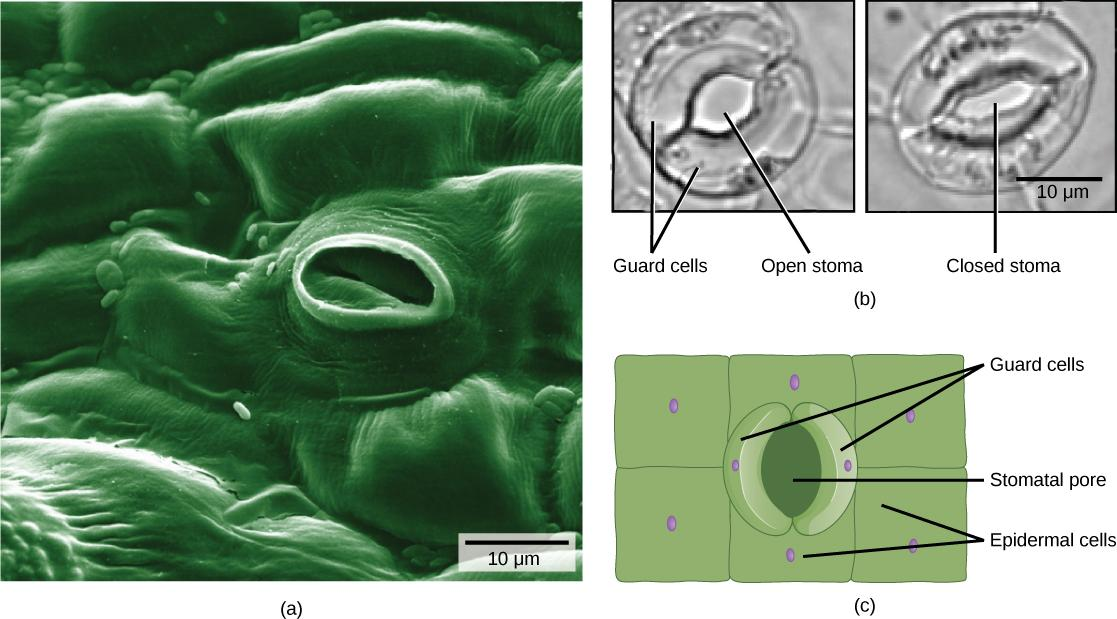
Answer
446.1k+ views
Hint: Stomata are small openings present on the surface of the leaf. These are the holes from where transpiration and gaseous exchange takes place. These stomata have bean-shaped guard cells which surround a small opening known as the stoma.
Complete answer:
To solve the given question, we must be aware of the mechanism of opening and closing stomata.
Many scientists put forth various theories regarding the opening and the closing of the stomata.

The inner lining of the guard cells is thick while the outer covering is thin. This helps in its opening and closing.
Photosynthesis production theory
This theory was given by Von Mohl. According to this theory when photosynthesis takes place in plants, starch is formed. This starch accumulates in the guard cells making them turgid. The outer thin covering bulges outwards taking along with it the inner thicker layer of the guard cells. Thus the stomata open. When this starch is utilized by the plant, the guard cell loses its turgidity and becomes flaccid. This leads to the closing of the stomata.
Starch-Sugar interconversion theory
This theory was given by Lloyd. According to him, the amount of starch increases during night while the amount of sugar increases during daytime. The opening and closing of the stomata are due to this interconversion between starch and sugar.
According to another scientist Sayre, stomata open when pH is higher than 7 while they close when the pH is lower than 5. This can be so because at high pH starch changes to sugar and vice-versa.
Note: Here it must be noted that several objections were raised against these theories. Some scientists believe that sugar-starch interconversion is a slow process and cannot be accounted for the rapid opening and closing of stomata. Further, sugar is not found in free state in the guard cells.
Complete answer:
To solve the given question, we must be aware of the mechanism of opening and closing stomata.
Many scientists put forth various theories regarding the opening and the closing of the stomata.

The inner lining of the guard cells is thick while the outer covering is thin. This helps in its opening and closing.
Photosynthesis production theory
This theory was given by Von Mohl. According to this theory when photosynthesis takes place in plants, starch is formed. This starch accumulates in the guard cells making them turgid. The outer thin covering bulges outwards taking along with it the inner thicker layer of the guard cells. Thus the stomata open. When this starch is utilized by the plant, the guard cell loses its turgidity and becomes flaccid. This leads to the closing of the stomata.
Starch-Sugar interconversion theory
This theory was given by Lloyd. According to him, the amount of starch increases during night while the amount of sugar increases during daytime. The opening and closing of the stomata are due to this interconversion between starch and sugar.
According to another scientist Sayre, stomata open when pH is higher than 7 while they close when the pH is lower than 5. This can be so because at high pH starch changes to sugar and vice-versa.
Note: Here it must be noted that several objections were raised against these theories. Some scientists believe that sugar-starch interconversion is a slow process and cannot be accounted for the rapid opening and closing of stomata. Further, sugar is not found in free state in the guard cells.
Recently Updated Pages
Who among the following was the religious guru of class 7 social science CBSE

what is the correct chronological order of the following class 10 social science CBSE

Which of the following was not the actual cause for class 10 social science CBSE

Which of the following statements is not correct A class 10 social science CBSE

Which of the following leaders was not present in the class 10 social science CBSE

Garampani Sanctuary is located at A Diphu Assam B Gangtok class 10 social science CBSE

Trending doubts
A rainbow has circular shape because A The earth is class 11 physics CBSE

Which are the Top 10 Largest Countries of the World?

Fill the blanks with the suitable prepositions 1 The class 9 english CBSE

What was the Metternich system and how did it provide class 11 social science CBSE

How do you graph the function fx 4x class 9 maths CBSE

Give 10 examples for herbs , shrubs , climbers , creepers

The Equation xxx + 2 is Satisfied when x is Equal to Class 10 Maths

What is BLO What is the full form of BLO class 8 social science CBSE

Change the following sentences into negative and interrogative class 10 english CBSE




